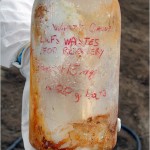 Clean-up personnel excavating the burial trenches at the Hanford nuclear site in Washington found the jug of historic Pu-239 in a concrete-lined safe.
Clean-up personnel excavating the burial trenches at the Hanford nuclear site in Washington found the jug of historic Pu-239 in a concrete-lined safe.
Established during the Manhattan project in 1943, Hanford was the first full-scale production site for plutonium. Hanford plutonium was used in the world’s first nuclear bomb test and in the bomb dropped on Nagasaki.
In order to determine its age, the researchers analysed the different forms, or isotopes, of plutonium and uranium in the sample. They found it had been separated from the spent fuel in 1944.
In order to determine which reactor had produced the sample, they compared plutonium isotope ratios from the contents of the bottle against technical data from nuclear research reactors that were operating at the time the sample was made.
Their results strongly suggested the plutonium was manufactured at the prototype X-10 reactor at Oak Ridge in Tennessee, which began operating in 1943, a year after the Manhattan Project was authorised.
 Researchers then found old shipping documents confirming transfers of spent reactor fuel from Oak Ridge to Hanford in 1944.
Researchers then found old shipping documents confirming transfers of spent reactor fuel from Oak Ridge to Hanford in 1944.
The only earlier sample of plutonium is from 1941 and is currently in the Smithsonian museum. This jug of radiation is going to stay with gummit scientists, though.